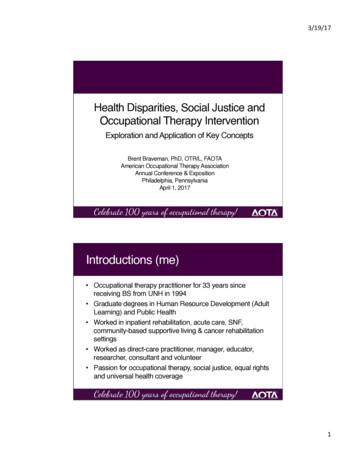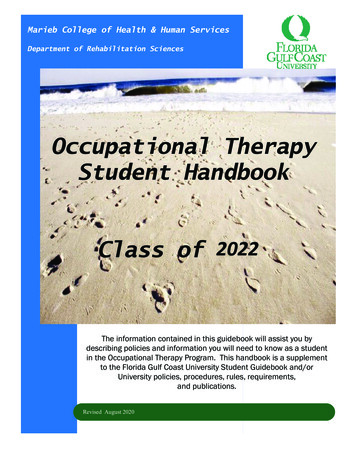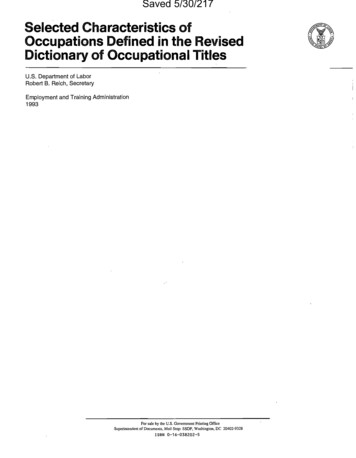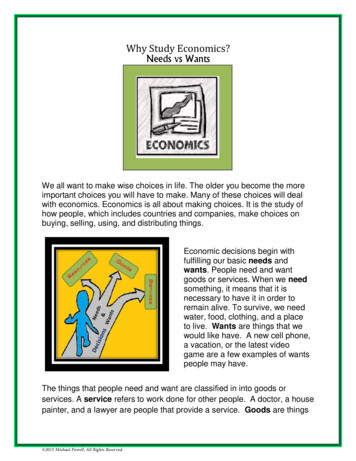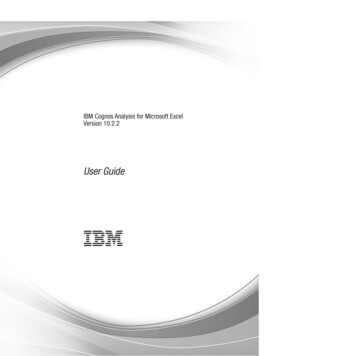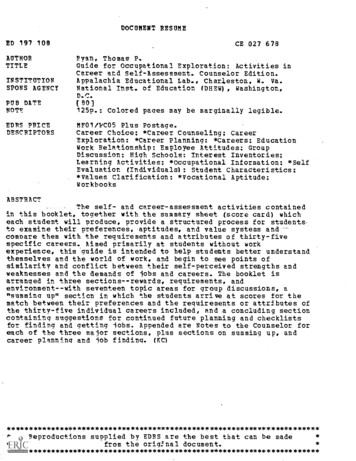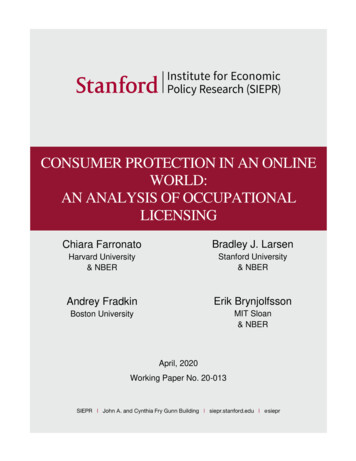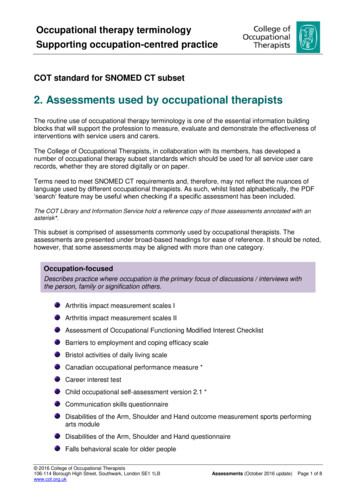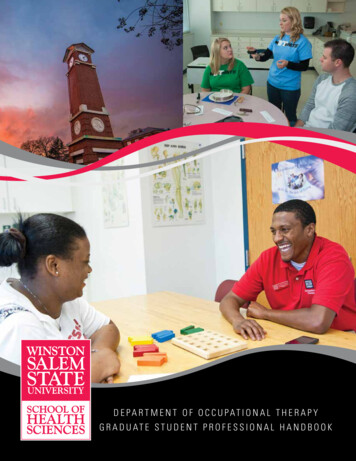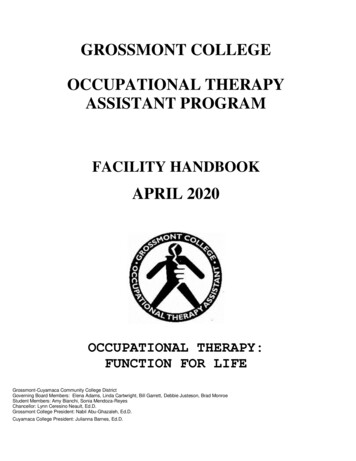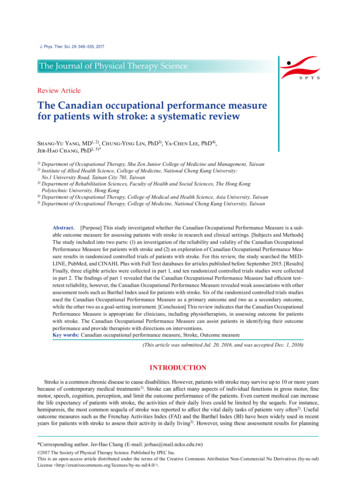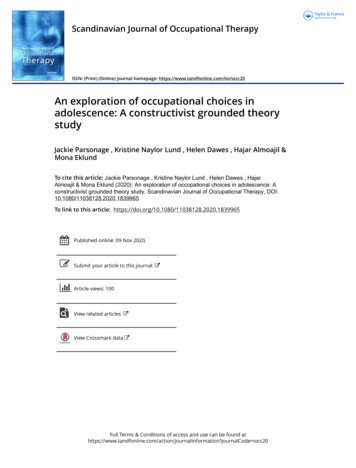
Transcription
Scandinavian Journal of Occupational TherapyISSN: (Print) (Online) Journal homepage: https://www.tandfonline.com/loi/iocc20An exploration of occupational choices inadolescence: A constructivist grounded theorystudyJackie Parsonage , Kristine Naylor Lund , Helen Dawes , Hajar Almoajil &Mona EklundTo cite this article: Jackie Parsonage , Kristine Naylor Lund , Helen Dawes , HajarAlmoajil & Mona Eklund (2020): An exploration of occupational choices in adolescence: Aconstructivist grounded theory study, Scandinavian Journal of Occupational Therapy, DOI:10.1080/11038128.2020.1839965To link to this article: shed online: 09 Nov 2020.Submit your article to this journalArticle views: 100View related articlesView Crossmark dataFull Terms & Conditions of access and use can be found ation?journalCode iocc20
SCANDINAVIAN JOURNAL OF OCCUPATIONAL 65ORIGINAL ARTICLEAn exploration of occupational choices in adolescence: A constructivistgrounded theory studyJackie Parsonagea, Kristine Naylor Lundb, Helen Dawesa, Hajar Almoajila and Mona EklundbaCentre for Movement, Occupational and Rehabilitation Sciences (MOReS), Oxford Brookes University, Oxford, UK; bDepartment ofHealth Sciences, Lund University, Lund, SwedenABSTRACTARTICLE HISTORYBackground: Adolescence is a critical period within the life course, for developing adult occupational competencies and health behaviours. Few studies have considered how 16–17 year oldschoose activities and behaviours from an occupational perspective.Aim and objectives: To explore how adolescents aged 16–17 years old make choices abouttheir daily occupations to inform a theoretical model of occupational choice.Materials and methods: About 27 secondary school students aged 16–17 years attended oneof six focus groups. Transcripts were analyzed using constructivist grounded theory, informingthe iterative development of a theoretical model of occupational choice.Results: Adolescent occupational choice occurred in response to experiencing needs, and wascharacterized by ‘weighing up’ and ‘juggling’ the following four key domains: ‘Appraising valuesand priorities’, ‘Interacting with the situational context’, ‘Exploring skills and occupational repertoire’ and ‘Considering time factors’. A developing sense of responsibility and autonomy foroccupational choices was described, leading to the development of the future occupational self.Conclusions and significance: A theory illuminating how adolescents make choices was developed. The theory aligns with existing developmental literature and provides unique insights,from an occupational science perspective, on the conscious process by which adolescents make,develop and adapt choices about the occupations they do considering contextual and individualopportunities and constraints.Received 20 April 2020Revised 12 October 2020Accepted 18 October 2020IntroductionAdolescence is widely regarded as a sensitive and critical period of development [1]. The period is associated with neurological, psychological, physiological,emotional, social and economic development [1–3], aswell as the development of the occupational competence required for adult roles [4]. Today’s adolescentsare developing in a rapidly changing world facingincreased uncertainties such as increased occupationalchoice, changes to normative working patterns,increased ‘free-time’, and existing in a culture of individualism as well as a digital online age in whichbehavioural norms are still being established [5,6].Health behaviours are established during this criticalperiod, consequently the study of adolescence is ofparticular interest to those hoping to improve thehealth and wellbeing of this population [7].The human experience of health, wellbeing andidentity has been linked to the activities orKEYWORDSActivity; late adolescence;occupation; occupationalbalance; occupationalchoice; time use;teenagers; wellbeingoccupations in which people engage [8]. The relationship between what a person does and the experienceof health and wellbeing is complex, and is thought tobe influenced by the meaning, purpose, value and balance of occupations [9–12]. This occupational perspective is an area of increasing interest to thoseseeking to promote health and wellbeing. New termssuch as ‘lifestyle psychiatry’ are being used to describeevidence such as the link between engaging in physical activities and mental health [13].According to a moral and ethical argument, complex interventions designed to improve health andhealth-related behaviours should be based on evidence-based logic models [14]. Consequently, effectivepromotion of healthy occupational patterns andbehaviours in adolescence that endure into adulthoodrequires an understanding of the adolescence occupational nature, experience and perspectives. The presence of the adolescent perspective is limited, in bothCONTACT Jackie Parsonage17002703@brookes.ac.uk, jackieparsonageresearch@gmail.comCentre for Movement, Occupational and RehabilitationSciences (MOReS), Oxford Institute of Nursing, Midwifery and Allied Health Research (OxINMAHR), Oxford Brookes University, Gipsy Lane, Oxford OX30BP, UKß 2020 Informa UK Limited, trading as Taylor & Francis Group
2J. PARSONAGE ET AL.the occupational science theory and the empiricalresearch literature. Time-use studies have begun toilluminate the complexity of adolescent occupationalpatterns in relation to health, but research to date hasbeen mainly quantitative in nature. Furthermore,existing research fails to consider trade-offs betweennecessary and desired occupations and focuses mainlyon single types of activities, for example, the impactof time spent in sedentary activities versus time beingphysically active [15].Similarly, the extent to which the empirical base ofoccupation-focussed models reflect the occupationalnature of children and adolescence is questioned [16].This raises the question to what extent adolescentoccupational choices are the same or different fromthat of adults. The concept of ‘Occupational choice’,defined in the Model of Human Occupation(MOHO) as ‘deliberate commitments to enter anoccupational role, acquire a new habit, or undertake apersonal project’ [p 14, 4], is also currently debated,particularly by those interested in adolescent or mental health perspectives. ‘Occupational choice’ as represented by the Model of Human Occupation (MOHO),and also other models such as the Canadian Model ofOccupational Performance and Engagement ce Model (PEOP), is regarded as basicallyindividualistic, with limited conceptualization of howchoices are shaped by the externally situated environmental determinants [17,18]. Taken together, toinform a logic model, we propose the need forresearch that delves thoroughly into a variety of external factors, and specific examination of the subjectiveprocess by which adolescent populations make choicesbetween one activity and another on a daily basis,particularly in late adolescence.Late adolescence, typically categorized as aged15–19 years of age [19], is an important educationaltransition point and a key time for the onset of mental health problems, which typically occur between 14and 18 years of age [20]. Rising levels of reportedmental health problems among adolescents haveplaced increasing strain on services with few youngpeople receiving timely and effective treatments[21,22]. Untreated or inappropriately treated illnesscan cause disruption to the normal development ofoccupational patterns, behaviours and choices withlong-term implications for future functioning [23].Improving our understanding of how young peoplemake choices can inform the development of occupation-based interventions to improve health outcomesduring this period.Consequently, this study focuses on a deepeningunderstanding of occupational choice during the critical period at a key educational transition pointwithin many school systems system. The ultimatepurpose of the study is to inform the logic model of alarger study to develop an occupational therapyinformed, evidenced-based intervention, to improvethe mental health of 16 to 17 year olds in a mainstream school environment.The study aimsThis study aimed to explore the processes involved inchoosing occupations from the perspective of lateadolescents in mainstream school and to develop aproposed theory to explain these processes.Materials and methodA qualitative methodology was chosen for this study,because it is considered to be best suited to understand the experience, meaning and perspectives ofparticipants [24]. Consequently, this methodologyenables the exploration of how adolescents makechoices and why. An open-ended, inductive constructivist grounded theory method was selected forits potential to build both substantive and general theories from qualitative data [25–27].The constructivist approach to grounded theory,proposed by Charmaz, considers knowledge and truthas created rather than objectively knowable, andemerging theory as co-constructed between researcherand participants, through the interactive research process [26–29]. This methodological approach was considered appropriate because it enables exploration ofconnections, identification of process, construction oftheory and acknowledges the researcher’s involvementand impact on the research process. This enables theresearcher to conceptualize how young people makeoccupational choices, and achieve the study aim.The researchers’ characteristics, reflexivity andtrustworthinessThe constructivist perspective acknowledges thatstudying a phenomenon influences both the data collected and its interpretation, and no consensus viewbetween researchers is considered necessary [29]. Theprimary researcher (first author), who is from a whiteBritish, middle-class background with 19 years of clinical experience as an occupational therapist aimed tocritically examine personal responses, avoid
SCANDINAVIAN JOURNAL OF OCCUPATIONAL THERAPY3A focus group method was used as it provides aninsight into the complexity of everyday interactions andnormative assumptions [30], whilst also being considered a less intense and more acceptable method for adolescence than one to one interviews [31]. The methodwas chosen as it provides an opportunity to engagewith the complexity of group dynamics and how peopleposition themselves in their environment [30]. Timeconstraints related to limited access to the school environment was a further rationale for the use of a focusgroup rather than individual interviews, allowing theinvolvement of more students. A first group was run topilot procedures and later included in the main study.delegated to the heads of year following a researchprotocol briefing.Across both schools, a total of 135 typical years 12students (aged 16–17 years) participated in the quantitative study and were invited to indicate their interestin being contacted about participating in focusgroups. The original research design intended to construct a stratified sampling frame based on adolescenttime use and wellbeing from which to purposivelyselect participants. Twenty-three indicated an interestin participating in a focus group. The low opt in ratesmeant that the planned stratified sampling frame, wasnot possible. Therefore, all 23 students were invitedto participate and given further information beforebeing asked for signed consent. One student indicatedan interest in participating but chose not to take partfor personal reasons after reviewing the study information and discussing alternative ways to engage.Following the low response rate, the pilot group wasalso incorporated into the analysis and viewed as anearlier iterative stage of the analysis process. A totalof six focus groups were conducted in English with atotal of 27 adolescents which included 22 of the 23who volunteered from the schools and the five participants from the initial pilot group.Recruitment, sampling and study proceduresThe sample description and demographicsThe first five participants were recruited purposivelythrough conveniently available personal networks forthe pilot group. The remaining participants wererecruited from two schools involved in multi-phasestudy to develop an occupational therapy intervention, the first phase of which involves a quantitativestudy examining time-use in relation to wellbeing. Inthis earlier quantitative study, gaining access toschools for research purposes had been difficult. Theprimary researcher emailed over 20 local schoolsinviting them to participate in the study.The first school recruited was situated in a lowincome, highly urbanized area with a broad range ofethnic diversity and was the only one to respond tothe email recruitment method. A minimum of twoschools were needed for the earlier quantitative study;therefore a second school was recruited via a teachingconsultant who, using her connections, approachedfurther schools about the study. The second schoolrecruited was situated in an affluent semi-rural location with a mainly white British population.Information was provided to the headmasters of bothschools prior to acquiring signed consent for schoolparticipation. Gate keeping responsibilities wereAll 27 participants spoke English, had recently completed their General Certificates of SecondaryEducation (GCSE), attended a mainstream local secondary comprehensive school and were either due tostart or had just started the first semester of year 12.Sixteen girls and 11 boys took part, 12 participantscame from the semi-rural school and 15 from theurban school, while the pilot consisted of five Englishspeaking, UK born girls. The urban school samplewas ethnically diverse with eight participants bornoutside of the UK (Romania, Russia, India, UnitedArab Emirates and Afghanistan), and nine of the participants (33% of the total sample) identified as nonwhite, such as Black or Asian. Two disclosed thatthey had previously been schooled in India. All participants had previously completed their EnglishGCSE qualification, demonstrated a good understanding of the English language and engaged actively andfluently in English throughout discussions.assumptions not grounded in the data, and ensurefidelity to constructivist grounded theory methods.Three female co-authors provided a critical and analytical reflexive space for the primary researcher todiscuss emerging ideas. The background of the coauthors includes; experience in conducting research, aprofessional qualification as an occupational therapistor physiotherapist, and different cultural backgroundsincluding British, Swedish and American.Study designEthical considerationsThe study was approved by a University ResearchEthics Committee (UREC no. 181192) and compliant
4J. PARSONAGE ET AL.with the good clinical practice (GCP) and requirements of the Helsinki declaration [32]. Those aged 16and over are considered able to give informed consentto participate in research studies of this nature.However, in the school setting, it is considered appropriate to keep parents informed about what occurswithin the school environment as those under the ageof 18 are still considered to be children.Consequently, parents were also informed aboutthe study.Data collectionAll participants were briefed on the ground rules,their rights and what to do if they felt distressed whileparticipating. The focus groups were conducted onschool premises during self-directed study periodsand each participant was given an online shoppingvoucher for 20 pounds to acknowledge theircontribution.An adapted version of an interactive card sortingactivity developed for 13–24 years olds called theActivity Card Sort—Adolescent, Children and YoungAdult (ACS-AYA) [33] was used as an warm-up exercise for the focus groups leading into the semi-structured topic guide (Figure 1). The tool usesphotographs depicting different activities to elicit livedexperience of engaging and participating in activities[33,34]. The purpose of using ACS-AYA was to promote rapport [35], active participation, engagement inthe topic of enquiry [36], and development of richdata. The semi-structured topic guide then formedthe main structure of the interviews (Figure 1)Additional prompt questions were used to exploreresponses related to the impact of occupationalchoices. Adaptions were also made to the topic guidebetween focus groups.There were between two and seven participants ineach group, and each audio-recorded session tookbetween 26 and 53 min. Audio recordings were transcribed verbatim by the primary researcher as advisedby Charmaz [29]. A reflexive diary was kept by theprimary researcher throughout the analysis. A secondresearcher observed and made notes, which the primary researcher used as an aide-memoire for her ownreflexive analysis. In order to maintain confidentialityand data security, pseudonyms were used, and alldata was kept securely according to the universitydata protection policies.Data analysis and saturationThe analysis was undertaken according to the constructivist grounded theory approach proposed byCharmaz [29]. The pilot group was analysed first,which involved each of the first four steps illustratedin Figure 2. Initial theory modelling was explored andwas later used in comparative analysis.Due to school timetables and the planned curriculum, access to the schools for the purpose of conducting the main focus groups was limited to 1 day forboth schools and occurred a week apart. Ideally, datais collected and analysed concurrently to enable categories and concepts to be identified, explored andtested through theoretical sampling until the data issaturated and a satisfactory theory developed [29].The fact that three focus groups were completed in1 day in the first school, and two in 1 day in the otherschool a week later, limited theoretical sampling basedon the detailed analysis between the data collections,potentially impacting on the iterative process of datageneration that is core to grounded theory. To mitigate the limited opportunities for theoretical samplingcaused by restricted school access, several actionsSemi-structured Topic guideThinking about the activity (ACS-AYA Cards) you just completed: 1) Is there anything you notice about the task you just completed?2)Are there any activities that are not here that you do? Alternatively, are there activities that you used to do but no longer do? Why didyou stop doing these activities?3)Of all the activities, you have identified that you do, are any more important or more meaningful to you than others are?4)Can you explain why ACTIVITY X is more important to you than ACTIVITY Y?5)How do you feel when you do an activity you feel is more important to you?6)When you are making choices about what to do with your time, what influences your choice?7)How would you feel if I asked you to do something you have not done before?8)What messages do you feel your culture gives about how you spend your time?Figure 1. Initial semi-structured topic guide.
SCANDINAVIAN JOURNAL OF OCCUPATIONAL THERAPY5Repeat for each of the six focus groupsTranscrip onof all 6 focusgroupsStep 1:Line bylineanalysisStep 2:Iden fyingcodesStep 3:ClusteringcodesintofocusedcodesStep 4:Wri ngdescrip on offocusedcodes,examiningrela onshipsand Ini alCategorydevelopmentStep 5:Step 6:Ini al theorymodelling anddevelopmentMove back andforth throughthe datacomparingcodes,developingfocused codesand looking forcontradictorycases.Step 7:Furthercategorydevelopmentand itera vedevelopmentof theoryand modelFigure 2. The analysis process.were taken. Firstly, the topic guide was adaptedbetween the pilot, the groups and between schools,based on initial reflections rather than after a detailedanalysis of each focus group. Secondly, each focusgroup was individually analyzed from step 1 to step 4as illustrated in Figure 2 before moving on to thenext focus group, enabling questions and ideas todevelop which could be explored in the next group. Achart was used retrospectively to record all themes inthe order that they emerged during the analysis,which confirmed that no new ideas emerged from theanalysis of the last group, thus suggesting that saturation had been achieved.Once all six transcripts were individually analyzedto step 4, a detailed process of constant comparisonwas undertaken as illustrated in steps 6 and 7 inFigure 2. Focussed codes and provisional categorieswere collated into a spread sheet that recorded whichcode emerged from which focus group. A total of 151individual codes were initially identified. Similaritiesand differences were compared before being reducedand refined to a core version, for which descriptivedefinitions were further developed. Specific attentionwas given to contradictory cases.Memos and reflexive notes were kept by the primary researcher at all stages of the data collectionand analysis process, ensuring attention was alsogiven to the relationships between codes, focussedcodes and categories. Through constant comparisonand moving back and forth through the data andmemos, four categories appeared to be strongly interconnected and of importance to the adolescent process of making an occupational choice. These maincategories would be described as domains and werecentral to the proposed model. The process of makinga choice appeared to begin with identifying the needand the urge to fulfil it. These emerging ideas wereexplored further in the data and through various diagrammatic models in an iterative process to develop acohesive proposed theory, which is described below.General grounded theory principles were followed,which advocate minimal literature reviewing prior todata collection [27]. Instead, literature was reviewedafter data collection to develop theoretical sensitivityand originality in relation to existing knowledge.Results: developing the future occupationalself through occupational choice andoccupational experienceThe findings that emerged from the focus group transcripts are presented as a proposed theory.Pseudonyms are used in place of participants’ names,quotes are written in italics and ‘FG’ refers to theoriginating focus group. An overview of the fourinter-connected domains that make up the core of theproposed theory is explained first, followed by anexplanation of the two sub-processes involved in theoccupational choice.The proposed theory starts as the adolescent firstexperiences a need to engage in an occupation for aspecific purpose, such as the need to connect withothers, need to achieve, need to become competent,need to relax and need to develop. This promptsthem to engage in a complex process of weighing upand juggling at least one of four interconnecteddomains; Appraising Values and Priorities, Interactingwith the Situational context, Exploring Skills andOccupational Repertoire, and Considering Time factors (see Figure 3 for illustration of the core model ofthe theory).
6J. PARSONAGE ET AL.Experience ofneed(s)Weighing up & JugglingDomainsAppraising Values& gwith theSituationalContextExploring Skills &OccupationalRepertoireExperience ofengaging in chosenoccupationAppraising & evaluatinghow the experience met theneedFigure 3. The core theory model.The four categories describe four different butinterrelated domains that affect the process of choosing what to do. Appraising values and priorities referto the values and priorities that influence the adolescents’ choices. Values are made up of beliefs, preferences, opinions, ideas and norms that collectively arereflected in the importance and meaning placed onany given occupation or need. Regarding values, oneparticipant said, ‘I mean like my parents have done agood job of teaching me good values’ Komal (FG2).Priorities, in contrast, refer to the adolescents’ prioritization of one occupation or need against another,often based on the value of the occupation or needsuch as, ‘Well the things you know you should doyou have to do eventually, but you sort of puttingthem off to the last minute. Till you really have to doit’ Ben (FG4). The adolescents express that both values and priorities are influenced and based on thesocio-culture, gender and family norms in which theyoung person lives and develops. As illustrated byAbrial’s (FG4) response to a question about how culture shape choices of time use, ‘It depends causemy English family are like do what you want but myDad’s family (from Asia) are very how’s your schoolwork and did you get good grades all my cousinsare like sometimes we pull all-nighters and I’m likeyeah, I get to 9 and that is enough work for me.’They also appear to reflect the way occupation is classified, judged and prioritized within the communityin which the adolescents live, providing standards ofcompetency and mastery by which occupation is perceived to be given a value, participation appraised,and experience is judged. For example, one participant said: ‘I think there is a feeling like when you arerelaxing you have had a really busy day you aresure you should not be doing anything but you feelyou should revise or whatever’ Maria (FG5).The interacting with the situational context refersto the present physical and social situation or environment in which the adolescents find themselves, andhow this affects them. This can also include; specificpreferred environments; whom they are with or wherethey are at a given time; and the resources availableto them such as money, internet or the nature of thesupport provided by others. For example, one adolescent who was sent to the UK by his parents underthe conditional that he must perform well in his studies, demonstrates awareness of the impact of his
SCANDINAVIAN JOURNAL OF OCCUPATIONAL THERAPYsituational context on his choices of occupation: ‘Ipersonally don’t get much pressure at home because Iam already aware of what is at stake’ Barry (FG3).Exploring skills and occupational repertoiredomain describes the personal resources and skills anindividual has, including both their perception ofconfidence in using their skills and their past experiences of using these skills to meet arising needs. Skillsdescribe the unique abilities required to complete anoccupation while the occupational repertoire is thelibrary of experience from which an individual candraw as in this example of learning to cook: ‘Cookingis a really good activity to do you learn new thingswhich helps out later in life’ Tom (FG5).Finally, considering time factors domain refers tothe multiple aspects of time, such as its perceivedvalue, the amount of time available, deadlines, lengthof timelines and how well the participants feel theymanage time. For example: ‘I think I have poortime management skills I will have forgotten aboutcertain homework and then I’ve realised I have to doit and it might be late into the night that I might startdoing something’ Barry (FG3).Weighing up and juggling these domains is thenfollowed by making an occupational choice (sub-process 1) and then the experience of engaging in thechosen occupation. The nature of the experience isthen appraised/evaluated as to how the experiencemet the need, leading the adolescent to weigh up andjuggle the experience in relation to the four domains.These results in nuanced and personalized version ofthe domain: ‘If someone is trying to tell me to dosomething I personally don’t listen. I think I knowmyself. I know what I am doing is the correct way ofdoing things’ Gemma (FG3). These domain modifications have the potential to influence future occupational choices and contribute to the construction ofthe emerging occupational self (sub-process 2).Detailed model descriptionThe model presented in Figure 4 illustrates the twomodel sub-processes; Making a choice and doingoccupation, and the Emerging occupational self,which are added to the core model presented earlierin Figure 3. The two separate sub-processes are theactive processes involved in choosing an occupation,and are connected through the four central domainsalready described.Sub-process 1:Experience ofneed(s)Making a choice anddoing occupationWeighing up & JugglingDomainsAppraising Values& gwith theSituationalContextExploring Skills &OccupationalRepertoireSub-process 2:Experience of engaging inchosen occupationEmergingOccupational SelfAppraising & evaluating howthe experience met theneedFigure 4. Detailed model including sub-processes.7
8J. PARSONAGE ET AL.Sub-process 1: making a choice anddoing occupationThis process involves the adolescent ‘weighing up’and ‘juggling’ the four domains, with the purpose ofinforming which occupation to choose to best meetthe identified need.Domain: appraising values and priorities whenmaking a choice and doing occupationThe adolescent engages in a process of weighing upthe value and priority status of the identified occupational need and any potential occupations that maymeet that need. Simultaneously they also engage in aprocess of juggling the external values and prioritiesthat structured and guided earlier stages of development, and their own internalized and emerging valuesand priorities, as illustrated by Gurdip (FG3): ‘If youthink it’s wrong, you think twice like should I do it,should I not do it and study?’ Values and prioritiesappear changeable and can be influenced by the otherthree domains, such as the availability of time, theadolescents’ skill level and the context in which thechoice and occupation take place.Adolescents appear more likely to ascribe a higherpriority status to occupations in which they findenjoyment. As the participant Charles (FG4) articulates, ‘if you like something more than somethingelse, you are obviously going to do the thing you likemore obviously than the thing they should do.’ Thereis a clear sense of thei
ORIGINAL ARTICLE An exploration of occupational choices in adolescence: A constructivist grounded theory study Jackie Parsonagea, Kristine Naylor Lundb, Helen Dawesa, Hajar Almoajila and Mona Eklundb aCentre for Movement, Occupational and Rehabilitation Sciences (MOReS), Oxford Brookes University, Oxfor
